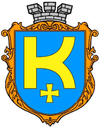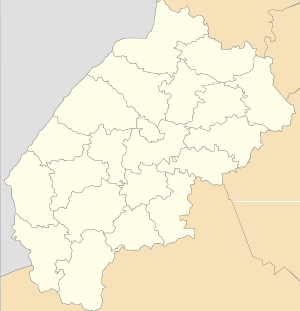Komarno, Ukraine
Komarno (Ukrainian: Комарно, Polish: Komarno, Yiddish: קאָמאַרנע) is a city located in Horodok Raion (district) of Lviv Oblast (region) in western Ukraine. Local government is administered by Komarnivska city council.[2] Its population is approximately 3,794 (2017 est.)[3].
Komarno Комарно [1] | |
|---|---|
City | |
 Flag  Coat of arms | |
 Komarno  Komarno | |
| Coordinates: 49°37′50″N 23°42′11″E | |
| Country | |
| Province | |
| District | Horodok Raion |
| Established | 1471 |
| Area | |
| • Total | 10.67 km2 (4.12 sq mi) |
| Elevation | 263 m (863 ft) |
| Population | |
| • Total | 3,842 |
| • Density | 360/km2 (930/sq mi) |
| Time zone | UTC+2 (EET) |
| • Summer (DST) | UTC+3 (EEST) |
| Postal code | 81562, 81563 |
| Area code(s) | +380 3231 |
| Website | місто Комарно (in Ukrainian) |
History
It was founded in 1324. In the center of town is an old Polish Kostel (Catholic Church), as well as an old wooden Ukrainian Orthodox church complete with ancient icons. The river Vereshytsia flows through the town.
The Jewish Hasidic dynasty of Komarno originates from this town, and there was a sizable Jewish community in the town from the 16th century until World War II.[4] Komarno, which until the Partitions of Poland belonged to Ruthenian Voivodeship, received its town charter (Magdeburg rights) in the mid-15th century from King Kazimierz Jagiellonczyk. The town was under protection of Voivode Stanislaw de Chodecz, who in 1473 founded here a Roman Catholic church. Komarno was a local center of textile industry. The town was divided into several districts, and remained in private hands of several voivodes. In 1590, it belonged to Jan Ostrorog, the voivode of Poznań, and in the 17th century, it was property of the House of Wiśniowiecki. Later on, Komarno belonged to the Ogiński family, and Lanckoroński family. In the 19th century, when it already was part of Austrian Galicia, the Lanckoroński family built here a palace. Last owner of Komarno was Countess Karolina Lanckorońska.
In 1648, during the Khmelnytsky Uprising, Komarno was besieged by the Cossack-Tatar forces. On 8 October 1672 the Battle of Komarno took place here, in which King Jan III Sobieski destroyed a 10,000 strong Tatar unit.
In 1918 Komarno returned to Poland, and by 1939, its population was app. 5,000. Until the Invasion of Poland, the town belonged to Lwów Voivodeship. Prior to World War II, the town had a Jewish population of over 2,000, very few of whom survived the Holocaust.[4]
Komarno has a former Roman Catholic church (1658), which in 1946 was turned by Soviet authorities into a warehouse. In 1992, Ukrainian government returned the complex to the faithful, but soon afterwards, it was handed over to the local Greek-Catholic community. Among people associated with Komarno are Jan Kilarski (mathematician), Countess Karolina Lanckoronska, linguist Roman Laskowski, historian Jozef Leszczynski, writer Karol Szajnocha.
Gallery
 Wooden church of Saint Michael, built in 1754
Wooden church of Saint Michael, built in 1754._Komarno.jpg) Church of St. Michael the Archangel (stone)
Church of St. Michael the Archangel (stone)- Roman Catholic Church of Nativity of the Blessed Virgin Mary
- Church of Saints Apostles Peter and Paul
- Monument to victims of the Tatar raids 17th century
References
- Mista UA Комарно
- Komarnivska city council Archived 2014-12-09 at the Wayback Machine
- "Чисельність наявного населення України (Actual population of Ukraine)" (in Ukrainian). State Statistics Service of Ukraine. Retrieved 26 August 2017.
- "The Jewish Community of Komarno". Beit Hatfutsot Open Databases Project. The Museum of the Jewish People at Beit Hatfutsot.